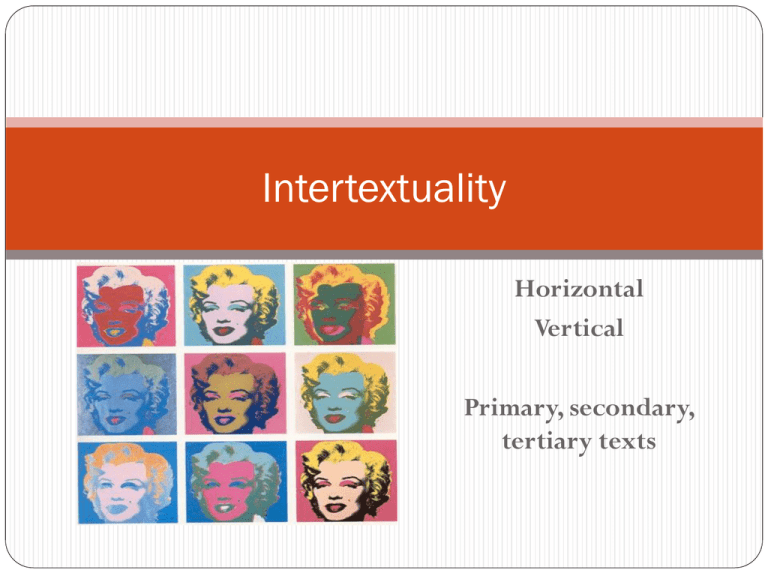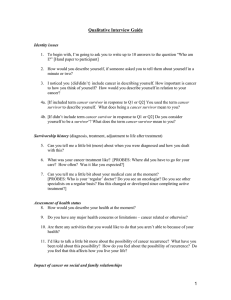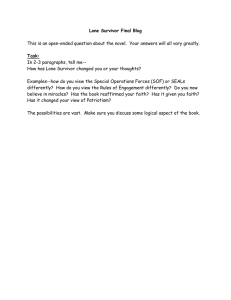Intertextuality Horizontal Vertical Primary, secondary,
advertisement

Intertextuality Horizontal Vertical Primary, secondary, tertiary texts Theory of intertextuality Any one text (literature, film, TV show, song, dance, game, etc.) is ‘read’ in relationship to others A range of ‘textual’ knowledge is brought to bear on a ‘reading’ of a text http://www.youtube.com/watch?v=xDav4PMjDMs&featur e=related http://www.youtube.com/watch?v=PluRW3_FEt0 Intertextual relations Two dimensions Horizontal – relations that are between primary texts that are more or less explicitly linked Vertical – relation between a primary text and other texts of a different type that refer to it (secondary and tertiary texts) Secondary texts – e.g., publicity, journalistic features, criticism Tertiary texts – produced by viewers themselves – e.g., letters, gossip, conversation Genre Genre is a cultural practice An order applied to texts and meanings that circulate in our culture for the convenience of both producers and audiences 3 strategies for constructing a genre Aesthetic – the characteristics of a genre Ritual – repeated exchange between industry and audience Ideological – the way that genres can be called upon to deliver audiences to advertisers by structuring dominant ideology into their conventions Genres are intertextual Genres and the Popular Genres are popular when their conventions bear a close relationship to the dominant ideology of the time Survivor, intertextuality, genre Survivor is part of a larger trend in the television industry toward the production and global proliferation of so-called reality television (RTV). forms and conventions are understood as part and parcel of a specific genre "reality television" & unscripted or "documentary" feel reliance on "ordinary people" rather than professional actors thematic emphasis on contest, competition, strategy and winning explicit claim to "veracity" and "authenticity." genre's implicit claim to capture "reality" accurately and faithfully Intertextual constructedness of television texts. Survivor owes as much to game shows and soaps, as it does to the castaway premise of Gilligan's Island, and the contrived social arrangements of The RealWorld. Dominant ideology – gender (and race) relations of our time Horizontal relations What Survivor is and is not Conventional elements of Survivor and other representations: Survivor II:The Australian Outback, Survivor Season One:The Greatest and Most Outrageous Moments, etc. Vertical relations Secondary texts Survivor fans & "official" Survivor merchandise like baseball caps, bandanas, T-shirts, books, and a soundtrack recording featuring "survivor-themed" music. Early Show, CBS's struggling morning program, began featuring interviews with Survivor participants, ratings soared the cast of Survivor has found its way onto various CBS programs including: JAG, Nash Bridges, and The Guiding Light, to name a few. survivors have found their way onto the nation's radio waves cameo appearances by these survivors help promote other CBS programs and media outlets. Vertical relations Tertiary texts proliferation of web pages devoted to the show demonstrate the level to which audiences invest meaning into the show's "characters" its "plot twists" and its "resolution." online chats and water cooler discussions illustrate that audiences take away different meanings from media texts: meanings that are determined, in part, by an individual's race, class, gender, ethnicity, and lifestyle. Survivor's meaning, therefore, does not reside solely in its images, words, and sounds, but rather is produced by audience members. level of popular discussion of reality television in general, and Survivor in particular, indicates that these programs resonate with audiences and that viewers do indeed take these shows seriously. Some Analysis Survivor is indicative of a society enamored with voyeurism, titillation, and spectacle. Survivor and other reality programs which place "ordinary" people in extraordinary situations demonstrate the lengths to which some people will go to achieve even fleeting moments of fame and celebrity. reality television programs tap into deep-seated cultural anxieties related to fundamental issues of individual autonomy, privacy, security, and survival. Like other forms of popular culture, then, Survivor is a polysemic text: a cultural artifact whose meanings are not rigidly determined nor fixed, but rather open to different interpretations. Media scholar John Fiske "Communication is too often taken for granted when it should be taken to pieces."


